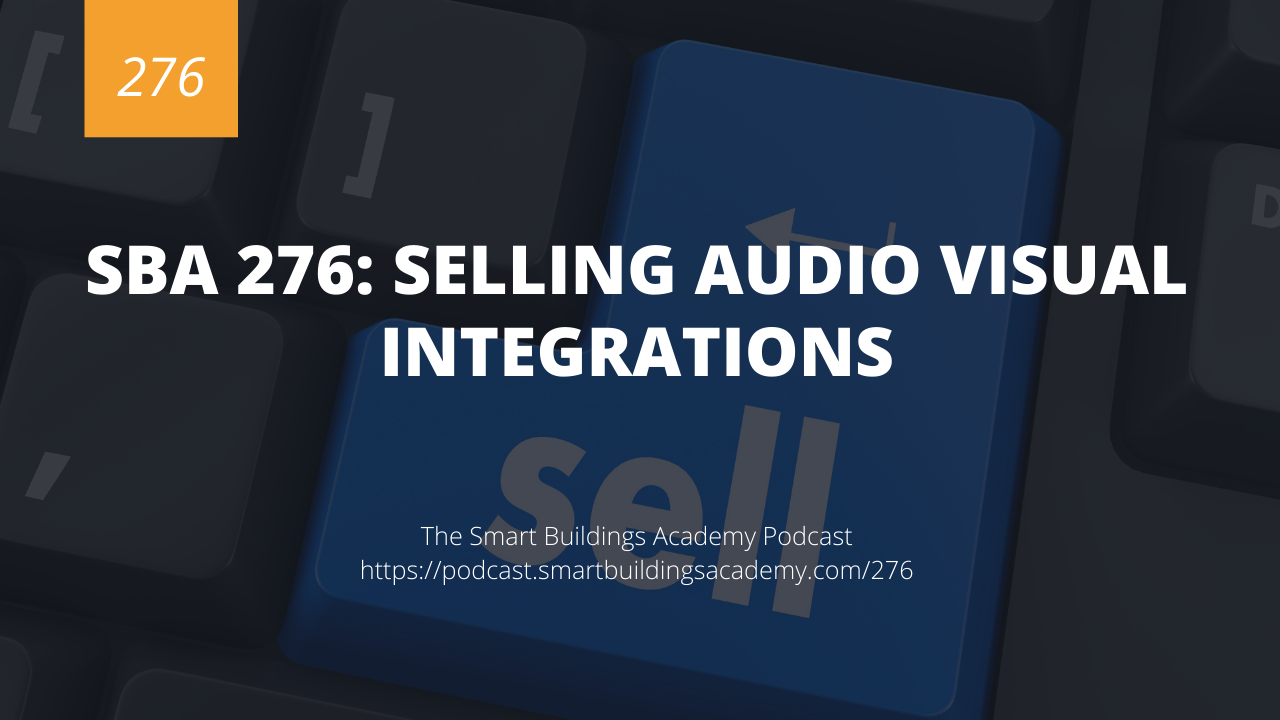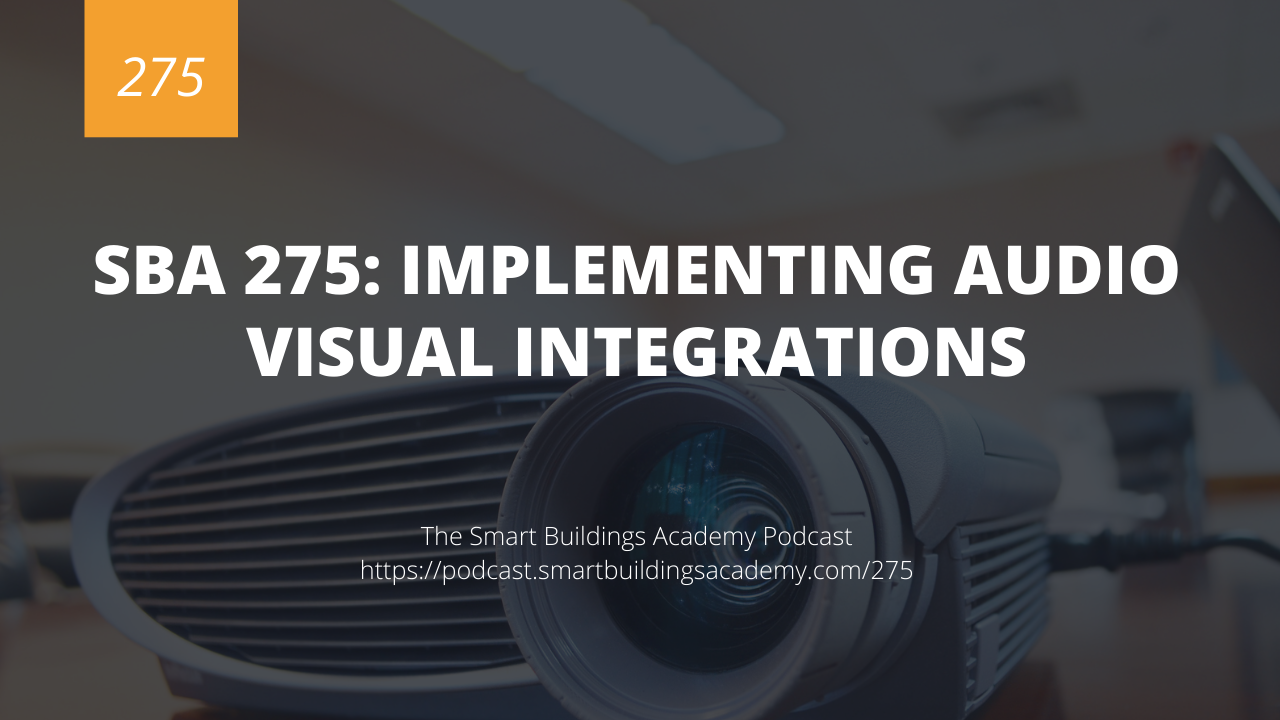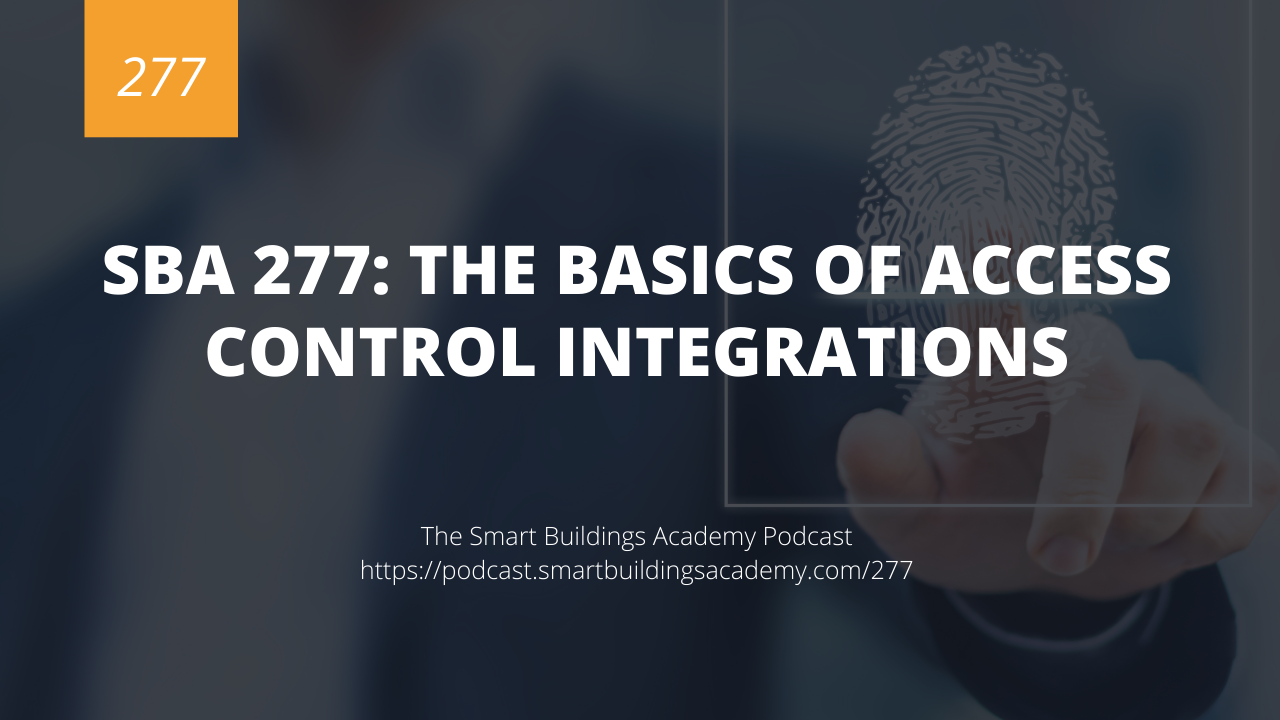In this episode we discuss how to estimate, position, and sell audio visual integrations.
Click here to download or listen to this episode now.
Resources mentioned in this episode


Transcript
Phil Zito 0:00
This is the smart buildings Academy podcast with Phil Zito Episode 276. Hey folks, Phil Zito here and welcome to Episode 276 of the smart buildings Academy podcast. And in this episode we are going to be discussing selling audio visual integrations. Everything we discussed can be found at podcasts and smart buildings academy.com, forward slash 276. And I encourage you to listen to our previous episodes on integrations as we are halfway through this integration series now, and there was a lot of really good information covered. And it will really help you understand what we're going to teach today. Just a update next week, our VA s sales bootcamp Cohort Two is beginning. I encourage you, if you are an estimator, if you are in sales, and you would like a very quick path to become a better estimator to become a better building automation salesperson that I encourage you to enroll in this boot camp. You know, one of the things I really appreciated when I worked at Johnson Controls, and I've heard other folks who work at OEMs mentioned this as well, is the level of depth of their sales training programs. However, I look out in the market and I see a lot of system integrators, a lot of contractors out there, who just due to their size due to just how they're structured. They have technical training programs, but their sales training program is more experiential and OJT. What our sales bootcamp is providing you is a online interactive sales training program that just takes an hour and a half a day over nine days, and is going to teach you VA s fundamentals, mechanical fundamentals it fundamentals how to estimate how to scope how to deal with retrofit opportunities, how to deal with solution selling, you're going to come out of this program, better able to estimate and close business for your building automation company. So if that sounds cool to you, then I encourage you to go to podcast dot smart buildings academy.com Ford slash 276, there still are some seats available for you to enroll. And this is your going to be your last chance for you to actually purchase it at the 790 $9 range, because it'll be going up to 20 $500 after this cohort, so this is your last chance to get it while it's still at that lower price.
Phil Zito 2:31
Alright, that being said, let's dive into selling audio visual integrations. So what does this look like? In my experience, there's really kind of two ways this comes together. And if you have listened to the previous episodes, it's gonna sound pretty familiar. But I'm gonna assume that you haven't. So the two ways this comes together. First is via specifications, you get a plan and spec or a design build specification. And in div 23. In section one, there is going to be, you know, additional sections, additional specifications that are involved, and those are going to be the audio visual one, there may even be a mention of integrating to the audio visual system, but that's typically all you will get. And that's where things go wrong. That's where things go very wrong. Because oftentimes, you are not going to get, hey, we want the building automation system data on these points, hey, we want to be able to display it and make it interactive for this oftentimes, right wrong or indifferent. Those AV audio visual use cases are not actually designed and implemented until warranty phase at the latest or at the earliest warranty phase. So how do you go and you estimate this? How do you understand what is expected? How do you understand if I'm having to do a protocol integration? Or if I'm having to do an API integration? How do you understand the level of support that you may or may not need to provide to the audio visual manufacturer or contractor? These are all great questions. And here's how I break it down. The first thing I determine right, the first thing I determine is what system is in control. Because if I am simply pulling data out of the AV system that is a lot different than me simply providing data to the AV system. They can be equally complex, but they have complexity at different stages. If I'm providing data to the AV system via BACnet, right, very common BACnet IP, then from an estimating perspective, that's pretty easy. For me to cost out, right? How much time do I need to potentially give for support for the AV contractor. And that will typically be a day or two, right a day or two, because once they get one of your points mapped in, once they get it communicating to one set of points, they can follow that process and do it again and again and again, where it gets very time consuming and where my risk alarm starts to go off. And I start to say to myself, man I better account for this is when I have to pull data out of the AV system. Because now at this point, I am dependent on their system and its nuances. Most AV systems are not bti listed, they have not been tested for their compliance to back net. And it gets even worse if I need to pull data out via an API. So what is an estimator or a salesperson to do? How do you go and estimate and scope out this work? The First things first, is we need to use the RFI process to get very clear on the scope and use case of the AV system. How are we using the AV system? Am I providing temperature control? Is the AV system the primary system is am I providing occupancy control? What level of control Am I providing? And am I pulling data out of the AV system? What data do I need? How often do I need it? What format does it need to be in? And what integration options does this AV system support? Is this something where I need to go to a gateway provider and get some sort of RESTful API to back that gateway, which is going to cost money and most importantly, time? Or is this something where it's a relatively simple BACnet IP interface, and I just need to make sure that I account for BBM, DS, bdts, subnets, etc, on the BACnet system so that it can properly integrate.
Phil Zito 7:08
Those are two totally different cost structures. If there is an API integration, that is a high risk integration, and it should be priced accordingly. If it is a back net protocol integration, and you're providing points to them, that is the lowest risk integration. If you're consuming points via BACnet protocol from the AV system that is a medium risk situation. Now I know those of you listening to this, are saying, Phil, tell me the numbers tell me the numbers, I can't tell you the numbers because medium risk to you could be a completely different risk could be a completely different burden than medium risk to one of your competitors. So for example, if you hired someone who used to work in a products group building back net integrations and API's, and they were your integrator, that person's version of medium risk is going to be completely different than if you hired someone who they've struggled in the past with integrating BACnet IP chillers. That person's level of risk, what medium to them is, is completely different than that previous person who has like product development and actual software programming development experience, so you need to account for that. Alright, so just be cognizant API's the most risky BACnet IP out of their system to you is the second like is medium risk. And then from you to the A v system BACnet IP is like the least risk. Okay? So how do you position this? How do you get involved? Well, if it's plan and spec or design build, there's not much you could do other than RFI and, and getting really clear on scope, and the use case of the AV system. That being said, if it is a owner direct, or a retrofit opportunity, you often will have much more involvement, specifically, if it's owner direct. Now, up to this point, I haven't talked heavily about use cases, I haven't talked heavily about business use cases, I want to give you a methodology to approach and this is going to be kind of off the seat of my pants in the system integration bootcamp course, we go into it in much greater detail. So I'm going by memory here. So it may be a little bit caddywhompus as far as the template here, but basically it is system or sorry, user system, business impact, ROI. That is the methodology. So the user would be yo maybe it's a tenant. Maybe it's the maintenance person, whoever the user is what is the system Our systems that would be like AV and building automation, what is the KPI the business impact that we're driving? And then what's the ROI on that? Now with AV integrations, it's typically much more difficult to figure out ROI because ROI. If you're doing like lighting to AV integration, there can be a hard ROI on that. AV system shuts down the lighting saves energy, right? But it's usually minimal because conference spaces, only a small subset of the overall tenant space. That being said, when you move into AV to be a s integrations, it's much more tenant experience. It's tenant satisfaction. And these are what I call qualitative KPIs. They're not quantitative. Anyone who tells you that they can measure tenant satisfaction. And tenant experience quantitatively, I'd say is full of crap. Because here's the deal. I go to the gym in the morning,
Phil Zito 11:03
I work out, I'm like working out, I'm doing crazy, heavy lifts, my body is burning, right? I'm super hot. I come into a space. And it's 72 degrees. But I feel like it's hot. So my tenant experience is this space sucks. It's hot, right? But the next day, I go and I don't work out, right, I don't work out, I've got the air conditioning blowing on me. I'm in my car. It's like 50 degrees outside beautiful day I walk from the car to the building, I come inside 72 degrees, it feels great, right? building automation systems great. What changed? It's 72 on both days. But I changed. That's why I think tenant satisfaction is a load of crap. Because if they get in a fight with their spouse, if they're hot, because they're running from the car, cuz they're late, their satisfaction of the space is going to be completely different, even though the space variables have not changed. So be cognizant that as you are driving, a use case, to those tenant experience and tenant satisfaction, KPIs, those are very fickle, I would call them weak KPIs. But the reality is for most of us with audio visual integrations, that's really the only KPI so there's an unwritten KPI though, that we need to be aware of. And it is my basically, keeping up with the Joneses, my space looks better than your space. You know, I always wondered, and, and I knew it at a subconscious level. But you know, back when I worked at Johnson Controls, we had this really, I would say it was a is a pretty nice, executive showroom, basically, with conferences and everything, I like to go up there and eat the snack food, I probably drove the people crazy, because they're like, the snack foods, not for you, it's for the customers, whatever, you know, I like food. So but the reality is, is those spaces. They just gave this presence, this experience. And it was part of the greater experience that just made people feel like oh, I'm in a nice place. And people have associations with nice places and values. And that puts them in a mental state to make high paid buying decisions, right. So if you're using your space for selling, that can be something you communicate to your customers, right, you can win when we start to get into some of these later integrations like AV access, control, you know, parking, etc. It's all about the experience, and it's painting the picture for your customer. So you become a very narrative driven salesperson. I know we're going way off topic here. But it's something I feel is just not properly taught. In selling that I've seen some of the best sales people do and it's narrative driven selling. You know, there's only so much you could do for plan and spec work, right? You quote you below and hopefully you're lower than the other person. Hopefully you got a relationship with the mechanical so you get less luck, right? That's kind of how it happens. But when we get into owner direct selling, or we get into collaborative selling, solution selling, we need to focus in on narrative. So our narrative in regards to audio visual integration with building automation systems is going to be about single point control. How high tech how Tony Stark Do you look, when people can come in and with their phones, they can have like a pre generated app in the phone with Bluetooth beacon tracking tracks them and knows their time. Temperature preferences and turns the spaces to their temperature preferences. Ooh, isn't that sexy? Isn't that cool. And also, it's like taking it a step further, when you go in there, and you can control the lights, you can control the access, you can control the shades, you can have digital signage, you can have temperature, all of this stuff integrated. That's a story. That's a narrative that paints the art of the possible for your customers and for your tenants. So that is something that is needing to be considered when you're selling integration.
Phil Zito 15:35
The reality is, at the end of the day, any of these integrations are going to fall into this low medium, high risk category, right? low risk being when I'm integrating and providing points available to others. medium is when I'm having to consume points out of a system using a protocol I'm common and understand well. And then high risk is using things like API's or protocols that I'm not well versed in, to pull data out of. So that is your big thing from an estimating perspective. But the really big takeaway I want you to take from this is narrative selling, have one or two good stories, good experiences associated with these technologies, and use those to tell your customer the story, help paint the vision, so that they can go and buy into that vision, make it their own, and then you'll be able to sell the solution. That being said, thanks so much for listening. I hope this was helpful. Be sure to go in the comments at podcasts at smart buildings academy.com Ford slash 276. Once again, that's podcasts that smart buildings academy.com Ford slash 276. And I encourage you if you're in sales and estimating and you really want to take your sales and estimating to the next level, then check out our VA s sales bootcamp. It'll be the best money you've ever spent. Thanks a ton, and I'll talk to you next week. Take care





